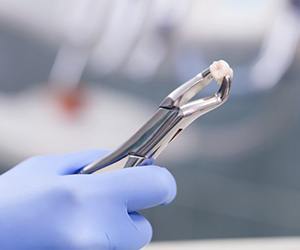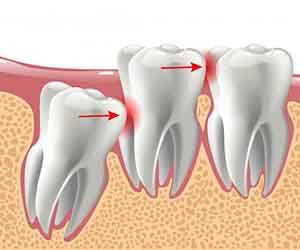








Dentists do everything they can to prevent the need for an extraction of teeth, whether it’s placing a filling or crown or performing root canal therapy. While teeth are incredibly durable, they cannot survive all levels of oral infection or physical trauma. If your tooth is badly damaged or simply at risk of infecting neighboring teeth, a tooth extraction will be needed. Dr. Megan McInnis will ensure that your treatment is as comfortable and successful as possible, so don’t wait to get it done. Call her office today to schedule your next appointment!

Even with the most advanced tooth replacement solutions out there, nothing is better than your natural teeth. This is one of the main reasons why dentists avoid extracting teeth if possible. With that said, there are many situations where a tooth will need to be fully extracted to protect your other oral structures.
These situations include:

When it comes to tooth extractions, there are two common scenarios that can appear. If your tooth is easily accessible, then we can perform a simple extraction. This requires administering a local anesthetic to the tooth and surrounding tissue to reduce as much discomfort as possible, then breaking the tooth from the periodontal ligament holding it in place. Next, we’ll grab the tooth with a pair of dental forceps in order to gently remove it from your jaw.
In the event that your tooth is impacted, we’ll need to perform a surgical extraction. This involves making a small incision in the gum tissue and repeating the same steps for a simple extraction. After the tooth is removed, we’ll close the gum tissue and go over your options for tooth replacement.

Immediately following your tooth removal, it is very important that you follow all aftercare instructions provided by Dr. McInnis. For the first 48 hours, make sure to get plenty of rest and stick to a soft diet. The last thing you want to do is overwork your jaw and accidentally dislodge the blood clot formed over the extraction site. This can result in a painful condition known as dry socket.
Minor discomfort is common after oral surgery and can be mitigated with over-the-counter painkillers. Swelling can be reduce via a cold compress. If you experience pain or swelling for more than a few days, contact our office right away for retreatment. During your healing period, you’ll need to practice daily oral care while avoiding the extraction site.

While it’s understandable to be nervous about a tooth extraction, many patients are also concerned about how much it will cost. Dr. Megan McInnis will only recommend a tooth extraction if it is in your best interest, and we’ll be sure to go over what you can expect to pay before you commit to the procedure. Here’s a basic outline of the factors that influence the cost of tooth extraction, but feel free to contact our office if you have any questions.

While it’s not easy to determine the precise cost of your tooth extraction until Dr. McInnis has had the chance to evaluate the tooth in question, there are several major factors that contribute to the final price. These include:

Dental insurance usually covers about 50% of the cost of tooth extraction once the deductible has been met, and this typically includes wisdom teeth. However, your plan may place limits on the number of teeth covered, and there may be a waiting period before your coverage takes effect. Since every plan is different, we’ll be happy to go over your insurance policy with you so you know exactly what it will pay for.

Since many people do not have dental insurance, we offer in-house membership plans that cover a range of services. Our individual plan covers two cleanings, two fluoride treatments, all needed X-rays, and one emergency exam if necessary, and it comes with a 10% discount on all treatments. The services covered by this plan can do a lot to prevent the necessity for tooth extractions, and the 10% discount can take the edge off the bill if you need one or more teeth removed.
Our team is ready and eager to assist patients with navigating the cost of tooth extractions. Please do not hesitate to contact us if you need any help.
Most patients are a little bit nervous that their tooth extraction is going to involve some level of discomfort, but thankfully there isn’t all that much to worry about in this regard. Before we start the process of removing your tooth, the first step will be to numb your mouth completely to ensure your comfort. As a consequence, the most you’ll feel during the procedure is some mild pressure.
It’s common for patients to be a little bit sore in the days after your treatment, but so long as you adhere to the aftercare instructions we provide you, this should fade after just a few days.
As dentists, our main goal is to preserve as many of your natural teeth as possible. That being the case, tooth extraction is generally our last resort—if we’re recommending that we remove your tooth, it’s likely because there’s no other option available.
If you’re dealing with a seriously infected tooth, there are some procedures that can be done to help you—deep cleaning, root scaling, and root canals can all be useful to a point. However, if the disease has advanced too far, these treatments may no longer be effective and removing the tooth entirely will be the only plausible way to prevent the infection from spreading.
There are several methods of tooth replacement available to you, and which one you ought to pick has a lot to do with your particular circumstances. Dental bridges, for example, are an excellent way to replace several teeth without the need for surgery. However, the nature of dental bridges is such that they’re really only able to replace consecutive teeth.
If you’re missing most or all of your teeth on a gum ridge, dentures are an easy and efficient way to replace them. They offer incredible coverage but tend to lack a bit in bite strength. Then there’s dental implants, which involve attaching a restoration to a thin metal post surgically inserted into the jaw. This provides them with incredible longevity and bite strength.
Smoking can delay healing in a number of ways. For one, the smoke itself can be irritating to the emerging wound, causing serious problems in some circumstances. Then there’s the fact that nicotine is a vasoconstrictor, meaning that it cuts off the flow of blood—this can impair the clotting and healing process.
If you smoke, you’ll also be producing a lot of suction that can pull the emerging clot out of place. This can lead to dry socket, which exposes the bone and nerve tissue underneath the wound.
For these reasons, we recommend that you avoid smoking in the days after your tooth extraction. You should try quitting for at least 5 days after treatment, and ideally for two weeks afterward.